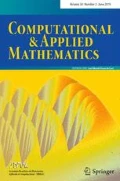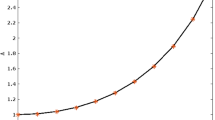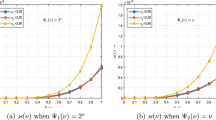Abstract
In this paper, we propose the fuzzy Shehu transform method (FSTM) using Zadeh’s decomposition theorem and fuzzy Riemann integral of real-valued functions on finite intervals. As an alternative to standard fuzzy Laplace transform and the fuzzy Sumudu integral transform, we established some potential useful (new or known) properties of the FSTM and validate their applications. Furthermore, the FSTM is coupled with the well-known homotopy analysis method to obtain the approximate and exact solutions of fuzzy differential equations of integer and non-integer order derivatives. The convergence analysis and the error analysis of the suggested technique are provided and supported by graphical solutions. Comparison of the numerical simulations of exact and approximate solutions of two fuzzy fractional partial differential equations are tabulated to further justify the reliability and efficiency of the proposed method.


Similar content being viewed by others
References
Agarwal RP, Lakshmikantham V, Nieto JJ (2010) On the concept of solution for fractional differential equations with uncertainty. Nonlinear Anal Theory Methods Appl 76(2):2859–2862
Akbarzadeh GZ, Mohseni MM (2011) Solving fuzzy differential equations by Runge–Kutta method. J Math Comput Sci 2:208–221
Akinyemi L, Iyiola OS (2020) Exact and approximate solutions of time-fractional models arising from physics via Shehu transform. Math Method Appl Sci. https://doi.org/10.1002/mma.6484
Akinyemi L, Iyiola OS (2020) A reliable technique to study nonlinear time-fractional coupled Korteweg–de Vries equations. Adv Differ Equ 2020:169
Akinyemi L, Senol M, Iyiola OS (2021) Exact solutions of the generalized multidimensional mathematical physics models via sub-equation. Math Comput Simul 182:211–233
Allahviranloo T (2008) An analytic approximation to the solution of fuzzy heat equation by Adomian decomposition method. Int J Contemp Math Sci 4:105–114
Allahviranloo T, Ahmadi MB (2010) Fuzzy Laplace transform. Soft Comput 14:235–243
Allahviranloo T, Salahshour S, Abbasbandy S (2012) Explicit solutions of fractional differential equations with uncertainty. Soft Comput 16:297–302
Allahviranloo T, Armand A, Gouyandeh Z (2014) Fuzzy fractional differential equations under generalized fuzzy Caputo derivative. J Intell Fuzzy Syst 26:1481–1490
Appadoo SS, Thavaneswaran A (2013) Recent developments in fuzzy sets approach in option pricing. J Math Financ 03(2):312–322
Bede B, Gal SG (2005) Generalizations of the differentiability of fuzzy number value functions with applications to fuzzy differential equations. Fuzzy Sets Syst 151:581–599
Belgacem R, Baleanu D, Bokhari A (2019) Shehu transform and applications to Caputo-fractional differential equations. Int J Anal Appl 17:917–927
Bezdek JC (1978) Fuzzy partitions and relations and axiomatic basis for clustering. Fuzzy Sets Syst 1:111–127
Bokharia A, Baleanu D, Belgacema R (2020) Application of Shehu transform to Atangana–Baleanu derivatives. J Math Comput Sci 20:101–107
Chakraverty S, Tapaswini S, Behera D (2012) Fuzzy arbitrary order system: fuzzy fractional differential equations and applications. J Comput Phys 231(4):1743–1750
Chang SL, Zadeh LA (1972) On fuzzy mapping and control. IEEE Trans Syst Cybern 2:30–34
de Oliveira EC, Machado JT, Kiryakova V, Mainardi F (2014) A review of definitions for fractional derivatives and integral. Math Probl Eng 2014:1–6
Dubois D, Oulloy L, Mauris G, Prade H (2004) Probability possibility transformations, triangular fuzzy sets and probability inequalities. Reliab Comput 10:273–297
Fatihu HM, Jen YH, Ahmed CI, Haruna C, Tufan K (2017) A survey on advancement of hybrid type 2 fuzzy sliding mode control. Neural Comput Appl 30(2):331–3531027
Gong Z, Hao Y (2018) Fuzzy Laplace transform based on the Henstock integral and its applications in discontinuous fuzzy systems. Fuzzy Sets Syst. https://doi.org/10.1016/j.fss.2018.04.005
Gong ZT, Wang LL (2012) The Henstock–Stieltjes integral for fuzzy-number-valued functions. Inf Sci 188:276–297
Henstock R (1963) Theory of integration. Butterworth, London
Jafari R, Razvarz S (2019) Solution of fuzzy differential equations using fuzzy Sumudu transforms. Math Comput Appl 23:1–15
Jafari H, Saeidy M, Baleanu D (2012) The variational iteration method for solving $n$-th order fuzzy differential equations. Cent Eur J Phys 10:76–85
Kahraman C, Onar SC, Oztaysi B, Sari IU, Cebi S, Tolga AC (2020) Intelligent and fuzzy techniques: smart and innovative solutions. In: Proceedings of the INFUS 2020 conference, Istanbul, Turkey, July 21–23
Khana MJ, Kumam P, Liud P, Kumam W, Rehman H (2019) An adjustable weighted soft discernibility matrix based on generalized picture fuzzy soft set and its applications in decision making. J Intell Fuzzy Syst 2019:1–16. https://doi.org/10.3233/JIFS-190812
Khana MJ, Kumam P, Ashraf S, Kumam W (2019) Generalized picture fuzzy soft sets and their application in decision support systems. Symmetry 11:415
Khana MJ, Phiangsungnoen S, Rehman H, Kumam W (2020) Applications of generalized picture fuzzy soft set in concept selection. Thai J Math 18:296–314
Khana MJ, Kumam P, Liu P, Kumam W, Ashraf S (2020) A novel approach to generalized intuitionistic fuzzy soft sets and its application in decision support system. Mathematics 7:742
Khana MJ, Kumam P, Alreshidi NA, Shaheen N, Kumam W, Shah Z, Thounthong P (2020) The renewable energy source selection by remoteness index-based VIKOR method for generalized intuitionistic fuzzy soft sets. Symmetry 12:977
Khana MJ, Kumam P, Deebani W, Kumam W, Shah Z (2020) Bi-parametric distance and similarity measures of picture fuzzy sets and their applications in medical diagnosis. Egypt Inform J. https://doi.org/10.1016/j.eij.2020.08.002
Khana MJ, Kumam P, Deebani W, Kumam W, Shah Z (2020) Distance and similarity measures for spherical fuzzy sets and their applications in selecting mega projects. Mathematics 8:519
Khastan A, Bahrami F, Ivaz K (2009) New results on multiple solutions for nth-order fuzzy differential equations under generalized differentiability. Bound Value Probl 2009:1–13
Kuzmin VB (1982) Building group decisions in spaces of strict and fuzzy binary relations (in Russian). Nauka, Moscow
Langari R (1992) A nonlinear formulation of a class of fuzzy linguistic control algorithms. In: 1992 Amer. contr. conf., Chicago, IL, pp 2273–2278
Liao SJ (1995) An approximate solution technique not depending on small parameters: a special example. Int J Non-Linear Mech 30:371–380
Machado JT, Kiryakova V, Mainardi F (2011) Recent history of fractional calculus. Commun Nonlinear Sci Numer Simul 16:1140–1153
Maitama S, Zhao W (2019) New Laplace-type integral transform for solving steady heat-transfer problem. Therm Sci 25:1–12
Maitama S, Zhao W (2019) New integral transform: Shehu transform a generalization of Sumudu and Laplace transform for solving differential equations. Int J Anal Appl 17(2):167–190
Maitama S, Zhao W (2019) Local fractional Laplace homotopy analysis method for solving non-differentiable wave equations on Cantor sets. Comput Appl Math 38(2):1–22
Najeeb AK, Oyoon AR, Muhammad A (2015) On the solution of fuzzy differential equations by fuzzy Sumudu transform. Nonlinear Eng 2015:49–60
Puri ML, Ralescu DA (1986) Fuzzy random variables. Anal Appl 114:409–422
Salah A, Khan M, Gondal MA (2013) A novel solution procedure for fuzzy fractional heat equations by homotopy analysis transform method. Neural Comput 23:269–271
Salahshour S, Allahviranloo T, Abbasbandy S (2012) Solving fuzzy fractional differential equations by fuzzy Laplace transforms. Commun Nonlinear Sci Numer Simul 17:1372–1381
Salii VN (1965) Binary L-relations. Izv Vysh Uchebn Zaved Matematika (in Russian) 44(1):133–145
Senol M, Iyiola OS, Kasmaei HD, Akinyemi L (2019) Efficient analytical techniques for solving time-fractional nonlinear coupled Jaulent–Miodek system with energy-dependent Schrödinger potential. Adv Differ Equ 2019:1–21
Senol M, Atpinar S, Zararsiz Z, Salahshour S, Ahmadian A (2019) Approximate solution of time-fractional fuzzy partial differential equations. Comput Appl Math 151:581–99
Shah K, Seadawy AR, Arfan M (2020) Evaluation of one dimensional fuzzy fractional partial differential equations. Alex Eng J 59:3347–3353
Tarasov VE (2011) Fractional dynamics: applications of fractional calculus to dynamics of particles, fields and media. Nonlinear physical science. Springer, Heidelberg
Valerio D, Trujillo JJ, Rivero M, Machado JT, Baleanu D (2013) Fractional calculus: a survey of useful formulas. Eur Phys J Spec Top 22(8):1827–1846
Wang Q (2008) Homotopy perturbation method for fractional KdV-Burgers equation. Chaos Solitons Fract 35:843–850
Yen J, Langari R, Zadeh LA (1995) Industrial applications of fuzzy logic and intelligent systems. IEEE Press, New York
Zadeh LA (1965) Fuzzy sets. Inf Control 8(3):338–353
Zadeh LA (1975) The concept of linguistic variable and its application to approximate reasoning I, II and III. Inf Sci 8(199–249):301–357
Zararsiz Z (2015) Similarity measures of sequence of fuzzy numbers and fuzzy risk analysis. Adv Math Phys 2015:1–14
Zureigat H, Izani AI, Sathasivam S (2019) Numerical solutions of fuzzy fractional diffusion equations by an implicit finite difference scheme. Neural Comput Appl 31:4085–4094
Funding
This research is partially supported by the National Natural Science Foundations of China (11571206, 12071261, 12001539, 11831010, 11871068), the Science Challenge Project (TZ2018001), and the National Key Basic Research Program (2018YFA0703903). The first author also acknowledges the financial support of China Scholarship Council (CSC) (2017GXZ025381).
Author information
Authors and Affiliations
Corresponding author
Additional information
Communicated by Anibal Tavares de Azevedo.
Publisher's Note
Springer Nature remains neutral with regard to jurisdictional claims in published maps and institutional affiliations.
Appendix
Appendix
In this section, we proof some basic properties of fuzzy Shehu transform.
Property 1
Linearity property. Suppose \(\tilde{f}(t)\) and \(\tilde{g}(t)\) be continuous fuzzy-valued functions, and \(\vartheta \) and \(\beta \) be constants, and then:
Proof
Let \(r\in [0,1]\) be arbitrary fixed. Then, using Eq. (21), we have:
The proof is complete. \(\square \)
Property 2
Scaling property. Let \(\vartheta \) be an arbitrary constant and \(\tilde{f}(\vartheta t)\) be an integrable fuzzy-valued functions, and then:
Proof
Using the Definition 9 of fuzzy Shehu transform, we obtain:
Let \(r\in [0,1].\) Substituting \(\zeta =\vartheta t\) and \(\mathrm{d}t=\frac{\mathrm{d}\zeta }{\vartheta }\) in Eq. (109) yields:
This complete the proof. \(\square \)
Property 3
Exponential shifting property. Let the \(\tilde{f}(t)\) be a continuous fuzzy-valued function on \([0,\infty )\) and \(\vartheta \) be an arbitrary constant, and then:
Proof.
From Eq. (21), we get:
Then, for any fixed \(r\in [0,1]\), we have:
Property 4
Multiple shift property. Let \(\tilde{f}(t)\) be a continuous fuzzy-valued function on \([0,\infty )\) and \(\mathbf{S} \left[ \tilde{f}(t)\right] (p,q)=F(p,q)\), and then:
Proof.
Applying Eq. (21) and Leibniz’s rule, we obtain:
Besides, to generalize the result of Eq. (114), we assume Eq. (113) holds for \(n=k\), and then:
Thus:
Thanks to Leibniz’s rule which help us to get:
The above result yields:
Finally, Eq. (117) validates the result of Eq. (113) holds for \(n=k+1\). The proof is complete. \(\square \)
Rights and permissions
About this article
Cite this article
Maitama, S., Zhao, W. Homotopy analysis Shehu transform method for solving fuzzy differential equations of fractional and integer order derivatives. Comp. Appl. Math. 40, 86 (2021). https://doi.org/10.1007/s40314-021-01476-9
Received:
Revised:
Accepted:
Published:
DOI: https://doi.org/10.1007/s40314-021-01476-9
Keywords
- Fuzzy differential equations of integer and non-integer order derivatives
- Fuzzy Shehu transform method
- Caputo gH-derivative
- Homotopy analysis transform algorithm
- Numeric-symbolic computation




